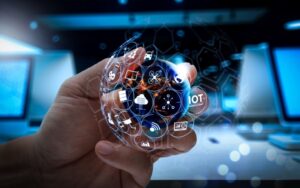Digital technology lies at the core of modern innovation, seamlessly connecting hardware, software, and digital platforms for greater efficiency and connectivity across industries. Understanding these components’ interactions to maximize their impact is of vital importance. As the digital landscape constantly shifts, organizations need to remain agile and swift when making implementation decisions.
1. Artificial Intelligence
Digital technology has revolutionized our world through its ability to transform information and processes. It transforms complex, ever-evolving information into discrete digital signals for accurate processing and usage, revolutionizing both business operations and everyday lives alike.
From cloud storage to internal communication systems, these technologies enhance productivity by eliminating manual work and increasing collaboration. They provide access to unlimited data while making it simpler for teams to respond to changes quickly and efficiently. Telemedicine allows patients to receive care remotely, while online learning platforms expand global education opportunities without physical attendance classes. Unfortunately, digital technology may pose risks like privacy breaches and a digital divide between various socioeconomic groups.
2. Big Data
Digital technology enhances operational speed and accuracy by automating tasks and eliminating human errors. Additionally, it enables businesses to interact with customers globally while streamlining service delivery.
Experts contend that digital technology is leading to an unprecedented era of inequality and may be detrimental to mental health and social interactions, creating addiction, isolation, and a lack of real-life interactions for users. They warn of problems like addiction, isolation, and the absence of face-to-face socialization due to overuse of digital devices. Big data refers to the massive amounts of information a company collects and analyzes from various sources, which possesses three qualities: volume, velocity, and value.
3. Internet of Things (IoT)
The Internet of Things allows physical devices to communicate using sensors, eliminating the need for human intervention and creating smart home ecosystems that make use of IoT for communicating with smart appliances such as connected thermostats for remote control by users.
IoT provides businesses with numerous business benefits by optimizing processes, reducing waste, and responding more quickly to unexpected changes. Furthermore, it enhances communication between devices by allowing them to exchange data more efficiently across the Internet, expanding network reach while conserving energy while prioritizing key communications. Touchless automatic doors enable people with limited mobility to gain entry to buildings more easily without lifting heavy doors, thus improving accessibility.
4. Virtual Reality (VR)
Virtual reality (VR) transports users into an immersive simulated world, offering engaging content. VR can be utilized for many business uses ranging from employee training and recruitment to encouraging creativity in learning environments.
Collaborative virtual reality allows people from disparate locations to meet in a virtual environment and interact with avatars or 3D characters, while another type of digital technology, augmented reality, overlays virtual simulations onto real environments—for instance, when furniture retailers create apps enabling customers to point their phones at rooms to visualize how new pieces would look before making purchases.
5. Artificial Intelligence (AI) Tutors
Artificial intelligence tutors (AI tutors) are revolutionizing education by offering students personalized learning experiences. Combining student data with innovative educational content, these AI tools help students comprehend and master complex topics at their own pace. Personal tutors offer direct one-on-one interaction, unwavering patience, and real-time feedback tailored specifically for individual learners. This tailored feedback enables faster and more profound learning while respecting students’ dignity by acknowledging both strengths and areas for development.
However, some educators worry that overreliance on digital technologies could create an imbalance and neglect in social interactions. Furthermore, cybersecurity issues like ransomware or exposed credentials raise other concerns, as well as cheating or plagiarism being possible risks.
6. Telemedicine
Digital technology allows us to connect globally and access information quickly, from video-conferencing software to messaging platforms such as WhatsApp. This technology has transformed how we live our lives.
Telemedicine, or distance healthcare, refers to the practice of using communications and information technologies for clinical services and to bridge geographic distance between those needing health care and those able to provide essential parts of that care. Telemedicine holds great promise for expanding both the quality and availability of healthcare, but the evaluations of clinical telemedicine programs lack an established framework or criteria to evaluate them effectively.
7. Wearable Technology
Digital technology enables us to do everything from completing bank transactions to communicating with loved ones across the world. It has also revolutionized how we live; touchless automatic doors create germ-free entryways.
While such applications are truly remarkable, they must also be evaluated against any risks they present to human dignity and privacy. Digital technology research should incorporate an examination of individual differences that include motivations, needs, and predispositions of users; for example, if devices could be compromised to record audio and video without consent—which would compromise their value altogether—this would significantly diminish their usefulness.
8. Virtual Meetings
Virtual meetings have become an integral part of modern work and often serve as an ideal alternative to travel for business purposes. Virtual meetings bring teams together in real-time communication channels that facilitate faster decision-making and streamline project workflows. However, virtual meetings can present unique challenges to participants. Frequent interruptions like email notifications and phones buzzing can lead to frustration and productivity loss; furthermore, decoding body language cues through pixels may prove challenging.
Keep meetings on track by setting an agenda that engages attendees through interactive activities such as polls or Q&A sessions. Starting off each meeting with an icebreaker can also help participants feel more connected and prevent virtual meetings from becoming unproductive tasks.
9. Social Media
Social media are platforms that enable two-way communication, in contrast with traditional one-way broadcast media like TV and radio. Users are able to share information, ideas, and opinions while finding entertainment through these social platforms.
Cultural shifts used to take years; now they occur almost instantaneously, with viral trends shaping public discourse faster than fact-checkers can catch them. This acceleration has allowed startups to expand globally quickly while social movements organize worldwide in seconds. Digital technology has become an indispensable part of modern life. However, this comes with certain challenges, such as cyberattacks, addiction, and its effect on mental health.



